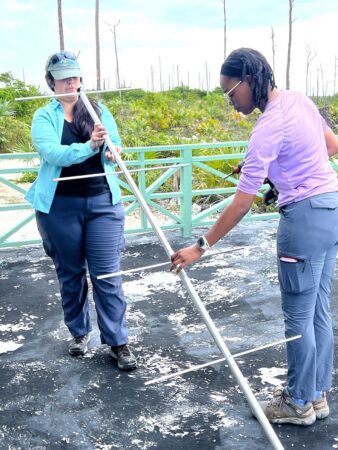
Our Motus stations are multiplying! Two stations were recently installed in The Bahamas, bringing the total to six stations in just over a year—starting with two in Puerto Rico, followed by one each in Jamaica and Barbados. You may ask, “Remind us what Motus is?” The Motus Wildlife Tracking System, often abbreviated to “Motus” from the Latin word for movement, is an international collaborative research network that uses coordinated automated radio telemetry to facilitate research and education on the ecology and conservation of migratory animals. Put simply, it tracks the movements of small animals and birds in flight.
The Caribbean Motus Collaboration (CMC) aims to fill the geographical gap in the network in the Caribbean. As more stations are added, we will be able to learn more about the movements of migratory birds throughout the islands. It is exciting work! We look forward to a future filled with Motus stations to help us learn more about how to preserve these remarkable species on their journeys. Here, Demonica Brown, Science Officer at The Bahamas National Trust, shares her story of how the first two Bahamian stations were installed, and the impact they will have.
Wildlife backpackers on the move
Flying animals such as birds, bats, and insects are safely captured by trained professionals and “tagged” with tiny, lightweight transmitters that look like miniature backpacks. When these animals fly within the range of receiver stations, detection data is transmitted and added to the database. Motus is a powerful tool that allows researchers to gain a greater understanding of how these species, especially birds, move around.
The islands of The Bahamas are popular wintering grounds for many migratory bird species. Similarly to tourists that travel to the Caribbean to escape the cold in their home countries, winter migrants from North America make their way down the eastern coast of the US to our beautiful islands, where many of them remain throughout their non-breeding season (fall through early spring). For some migrants, our islands serve as a stop-over location along their migratory pathway as they make their way further south. Over 300 species have been recorded in The Bahamas, with migratory species accounting for more than half of them.
Four stations slated for three Bahamian islands
Through the Caribbean Motus Collaboration, four new Motus stations will be installed across the country. Two stations will be set up on the northernmost island of Grand Bahama (described here). In the coming months, a third station will be installed on Eleuthera in the central Bahamas and finally, a fourth station on Great Inagua in the south! The installation of these stations is a big step towards better understanding how migratory, resident, and endemic species move throughout our islands and the Caribbean at large. I had the opportunity to assist with Motus tower installations on Grand Bahama, a first for myself.
Since I reside in Nassau (the capital of The Bahamas), located on the island of New Providence, I first needed to get to Grand Bahama. Fortunately, this only required a quick 30-45 minute flight. Upon arrival, I was picked up by Lisa Wildgoose (Rand Nature Center Office Administrator) and headed to drop off my bags at my host home for the next few days. There I met my host Martha Cartwright, a Grand Bahama resident and fellow birder, who graciously welcomed me into her home.
Getting started on Grand Bahama, still feeling Hurricane Dorian’s effects
Lisa and I then made our way to The Rand Nature Center (RNC), one of three national parks on the island. This park protects 100 acres of pine and coppice forest, as well as a freshwater pond, making it a hotspot for birds. There I met with the rest of the Motus installation team, which consisted of Lisa Sorenson (BirdsCaribbean Executive Director), Maya Wilson (BirdsCaribbean Landbird Monitoring Program Manager), Todd Alleger (Northeast Motus Collaboration Installation Expert), and Cesar Montero (Caribbean Motus Collaboration Trainee). Also on hand to assist were two BNT Park Wardens, Bradley Pinder and David Claire. Director of Parks, Ellsworth Weir, provided crucial assistance with procuring supplies and getting all of the shipped Motus equipment out of customs—no small feat!
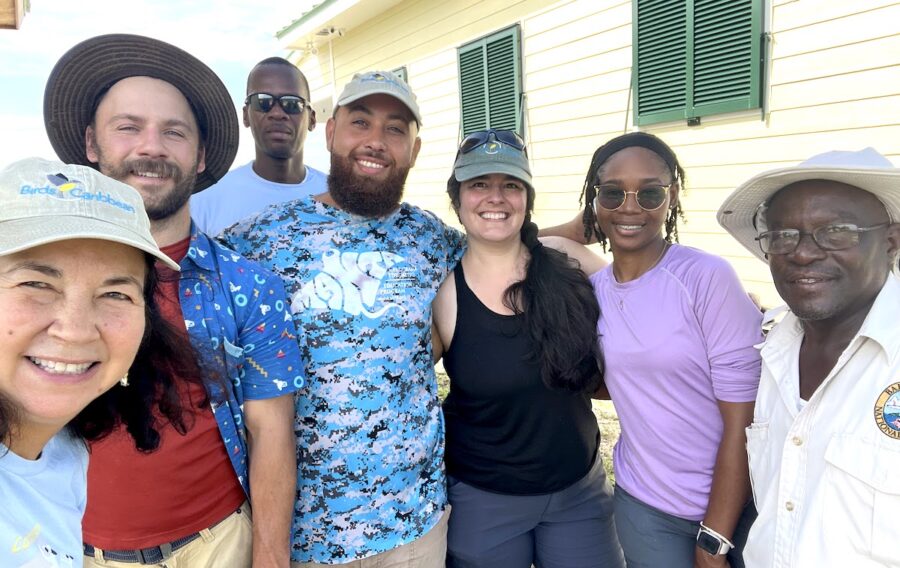
After catching up for a bit, we reviewed plans for the remainder of the week. To get started, Maya, Bradley, and I would start the work at Lucayan National Park (LNP) while the remainder of the team worked on getting additional supplies from the hardware store.
The scenery on the drive along the Grand Bahama Highway was somber. In 2019 Hurricane Dorian had ravaged this island for two full days. Winds of 185 mph, storm surge (up to 23 feet) and salt-water inundation drastically damaged pine, coppice, and mangrove habitats on both Grand Bahama and Abaco. These serve as vital habitats for many bird species, and their destruction resulted in the decreased population of many species including endemics such as the Bahama Swallow, Bahama Warbler (potentially extirpated on GB), and Bahama Nuthatch (potentially extinct). Though this is my second time visiting Grand Bahama post-Hurricane Dorian, it is still a sight to take in, with miles and miles of trees snapped in half. However, it was encouraging to see continued signs of regeneration, especially young pine growing, amongst the vast stretch of dead pine stands.
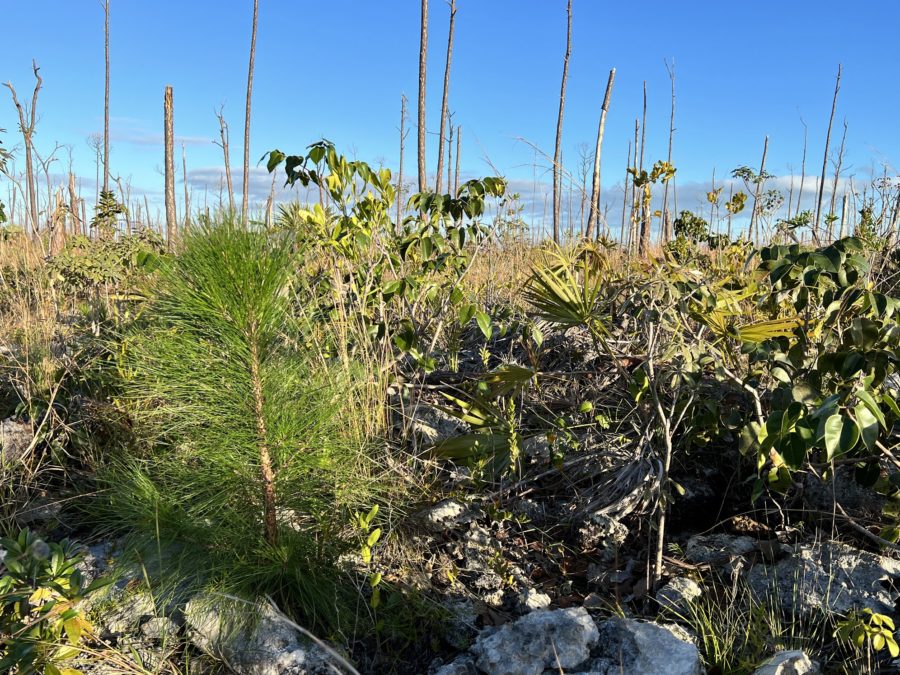
It was hard labor—shovels, buckets, and mixing cement!
After a 25-30 minute drive, we finally arrived at Lucayan National Park (LNP). Established in 1982, this park protects both marine and terrestrial habitats, including one of the world’s longest-charted underwater cave systems. There we were joined by Delores Kellman (BirdsCaribbean Administrative Assistant) and Bob Davies (BNT volunteer), who generously offered to assist. The station was going to be located on the back of the rebuilt LNP Gift Shop, and our first task was to dig the hole for the base of the station. Pickaxes and shovels in hand, the team quickly got to digging.
About a quarter of the way down, we were met with a slight issue—our hole quickly started to fill with groundwater! This resulted in us needing to bail out buckets of water multiple times throughout the morning. After reaching an acceptable depth, the team worked on creating the frame that would hold the concrete when poured. With a few fittings to the hole, leveling, and other necessary adjustments, the frame was finally set and the 5-ft Rohn section (first section of the tower) was added and stabilized.
We returned to LNP the following morning to continue working on the station. While waiting on the equipment needed to complete the base, the team worked on assembling the antennas for the tower and preparing the cables. Three antennas for each of the 2 standard radio frequencies used by the Motus network were assembled, for a total of six antennas. This process was simple and went by quickly with everyone helping out. As the Motus expert, Todd gave each antenna a final look to ensure that everything was in place! Once complete, we resumed work on the base of the tower. With the 5-ft Rohn base section secured in place, it was time to add cement to set it in place for good. Mixing cement by hand can be a laborious task, but thankfully we had the help of a mixer which made the process easier. Many bags of cement later, we were ready to pour!
While the rest of the team finished preparing the base, Lisa and I worked on collecting leaves and flowers of native plants, which were gently pressed into the top of the wet cement. With the cement successfully poured, and beautifully adorned, all it needed was time to dry. We finished off the remainder of the day at the Rand Nature Centre, where we prepared for the station installation the following day.
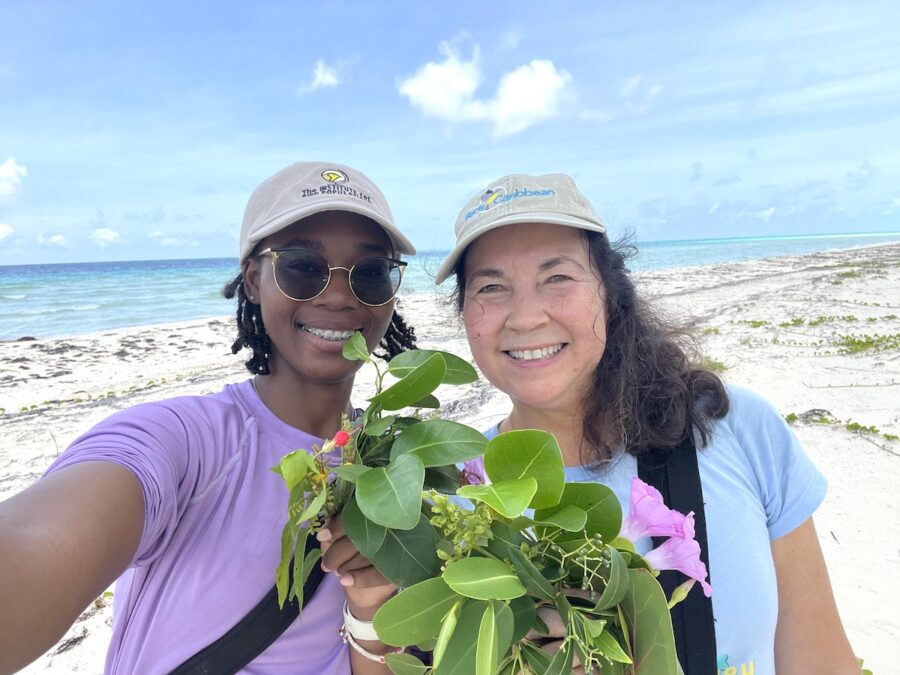
A birding break…
I started my final day with the team with one of my favorite hobbies: birding! Martha planned a morning tour and led us to a few birding spots on the island, including Dover Sound and Barbery Beach. Perfect weather allowed us the opportunity to record about 27 species in total, including an unexpected lifer sighting for myself (Purple Martin). Overall, the morning was a success! We also were fortunate enough to spot five Bahama Swallows near a cell tower along the Grand Bahama Highway on our way to LNP to pick up supplies. Eventually, it was time to get back to work and continue work on the RNC station.
…Then, back to work!
At RNC, I assisted with preparing the remaining antennas and cables for the station. Once assembled, colored coordinated electrical tape was added to antennas of the same frequencies and then down the cables for ease of reference when installing them to the mast and connecting to the receiver. Finally, it was time to erect the Rohn tower onto the base plate that was secured onto the existing concrete near the main entrance of the building. Once set in place and secured with bolts, it was then bracketed to the building for extra security. The next steps would then be to attach the antennas and coaxial cables and connect them to the receivers.
And the work continued…
Eventually, my time with the team came to an end and it was time to return home. The Motus team, however, kept hard at work and completed both installations before departing that weekend!
It is exciting to have these towers set up. I am looking forward to the data that will be collected and the research they will help to advance. In fact, the station at Lucayan National Park has already detected a migratory shorebird—a Semi-palmated Sandpiper that was tagged in Quebec, Canada! I am incredibly grateful to have had the opportunity to assist with this amazing work and to have the ability to see first-hand the work that goes into these installations. I would like to give a special thank you to BirdsCaribbean for including me in this work and to Martha Cartwright for her hospitality!
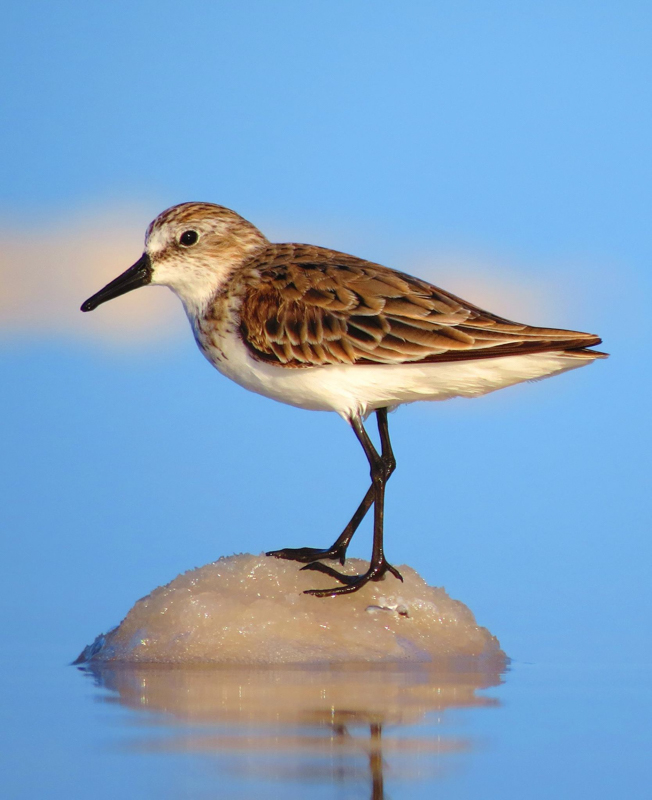
Demonica Brown is an early-career environmental scientist serving as a Science Officer at the Bahamas National Trust. In her current role, she focuses on avian and terrestrial matters in which she executes multiple bird-related projects involving monitoring migratory and resident birds. Understanding the importance of protected areas to these species, she is passionate about conservation and collecting valuable data that can also further aid in their management. She hopes to pursue a master’s in wildlife and environmental conservation and to conduct much-needed research on local threatened, endangered, and endemic bird species.
Acknowledgments
BirdsCaribbean thanks our members and donors who made the installation of these two Motus stations possible, including the US Fish and Wildlife Service, Neotropical Migratory Bird Conservation Action Fund and American Bird Conservancy (ABC). A huge thank you to Cesar Montero, and to Todd Alleger and the Northeast Motus Collaboration for their ongoing support (Todd now works as the Atlantic Flyway Motus Technical Coordinator with ABC). Thanks also to Martha Cartwright, Delores Kellman, and the BNT staff and volunteers who assisted in getting these stations up. Finally, much gratitude to Ed Gates and the late Erika Gates for supporting our crew on this visit with accommodations, transportation, and delicious meals. We dedicate these two new stations to the memory of Erika Gates, who was always striving to advance bird knowledge, awareness, and conservation in Grand Bahama and the Caribbean.




























